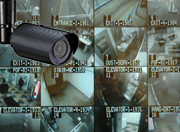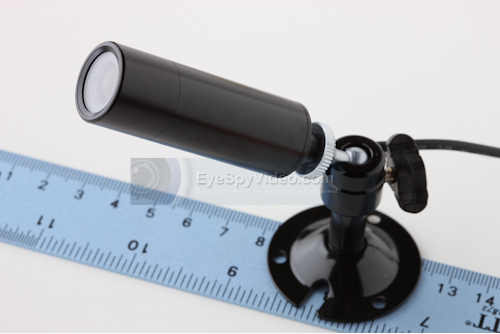Infrared (IR) ZERO
2. Is the light actually 100% invisible and, if so, how can the camera use it to "see"?
3. They see in the dark great, but how well do these cameras image in daylight?
4. Are all Infrared products I see out there pretty much the same?
5. What is a photocell and how is it useful in IR lighting?
6. There's a small amount of light in the area to I want to monitor- do I need IR assistance?
7. Do color cameras work with Infrared lighting?
8. What is a dual imaging chipset and what advantage does it offer?
9. Are there any common myths or exaggerations I should be aware of?
Q1: How does this technology work?
A1: To begin, there really is no camera which can actually 'see in the dark' (pitch dark is referred to as 'zero lux') on its own-though there are a couple larger CCTV cameras out there which come close. So, any camera claiming to do so must be aided either by visible/white or invisible (Infrared) light emitters of some kind. Infrared (IR) assisted cameras are generally found built as a low lux black & white video camera surrounded by LED emitters which cast light at a a frequency outside the visible light spectrum. The visible light spectrum starts at red (then orange, yellow, green, blue, indigo) and ends at violet. Any color you can imagine falls in there somewhere. Light which is outside our visible spectrum is either lower and called "infra" red or higher and called "ultra" violet. Back to top-->
Q2: Is the light actually 100% invisible and, if so- how can the camera use it to 'see'?
A2: The light cast out from our IR equipment is 100% invisible to the human eye, though higher powered IR cameras and spotlights (like ours) do have a visible dull red glow on the emitter elements themselves. For black and white video CCD video camera camera imagers, IR emitters cast light which is 'seen' as it would be with a visible light. Obviously, the brighter or more powerful the output of illuminators- the farther the light is cast. Eyespyvideo only carries equipment with high power Infrared emitters- beware of so much low illumination and low resolution systems flooding into the marketplace right now. Back to top-->
Q3: They see in the dark great, but how well do these cameras image in daylight?
A3: We really can't speak for the rest of the industry's products- but ours are great in daytime conditions. The picture viewed is as sharp as any of our other fine cameras- you'll only realize they're different after the sun goes down! One note worth mentioning- no video camera will perform well when directly pointed at a bright light source (sun, floodlights, etc.). The closer the light source, the larger the 'halo' effect. Such a condition is often easily remedied by the use of a sunshade or by simply pointing the camera down slightly. Back to top-->
Q4: Are all Infrared products I see out there pretty much the same?
A4: Not by a long shot. Exaggerated claims abound, usually as to the actual distance of illumination- or the actual resolution of the camera itself. Don't worry about our products though- we've hand selected the best for you. All of our IR cameras and spotlights will do what we claim and then some! Do not confuse with so many of the 'toys' or junk floating around out there. Most cameras you find with 6-10 emitter lights will rarely illuminate past 8-10 feet! Why? Much of our competition uses low power LED emitters- and that is why you see products out there which require a large cluster (up to and over 100 separate emitters) to do the same job as just a few high power emitters. Also, the larger clusters require a lot more electric current and create a lot more heat. Overheating problems have forced several cameras to be removed from the market, though many resellers are still carrying them- beware. Back to top-->
Q5: What is a photocell and how is it useful in IR lighting?
A5: A photocell, in terms of IR cameras and lighting, is simply a light sensitive switch that automaticallyturns the LED emitter bulbs on in the absence of light or off in the presence of light. What makes that beneficial? Well, IR emitters, like any light bulbs, don't last forever. For example, our IR-2HAD is rated for 6000 hours. Older versions (and quite a few you still see out there) DO NOT have a photocell and are therefore incapable of turning emitters off. The emitters are then lit constantly- wasting themselves in daylight hours. The ones that we use are actually quite amazing- very advanced and capable of adjusting to all sorts of lighting conditions- including, of course, pitch dark or "zero lux" condtions. Back to top-->
Q6: There's a small amount of light in the area to monitor- do I need IR assistance?
A6: A good question that's not easy to answer without actual field testing in the given location. Our black and white cameras (either weatherproof or an indoor unit mounted inside a window) require just a small bit of light (such as a streetlight) to image quite clearly. While not like the super bright "daytime" picture-. *NOTE: Overhead porchlights are generally not a good source of lighting- if too much illumination from the light gets into the immediate view of the camera, the imager will be tricked into 'thinking' that it is daytime and will automatically turn off it's light boosting (or gain) ability and create a lot of darkness in. Plus, they don't cast much distance for illumination. Floodlights, on the other hand- may be an EXCELLENT illumination source if pointed toward target area with none of its light pointing back toward camera lens. A general rule is that there's no such thing as overkill when it comes to attaining the best quality video. Back to top-->
Q7: Do color cameras work with Infrared lighting?
A7: No- the nature of the way colors are imaged doesn't allow it. Any time you see or hear the words "color" and "Infrared" in the same camera, it must either have two separate cameras OR incorporate the new "dual" imaging chipset technology (i.e. our #CC-X2, #IR-5HAD or #IR-5EX). Back to top-->
Q8: What is a dual imaging chipset and what advantage does it offer?
A8: A 'dual- imaging' chipset is so named for its ability to automatically revert from imaging in color to black and white when encountering lower lighting conditions. This technology is a breakthrough as many want color- but are finally beginning to understand its drawbacks in lower lighting conditions- where it may appear grainy. Rather than having to switch between two separate cameras for alternating light conditions, a dual imager allows the same camera to view in color when lighting is adequate, but switch to monochrome / black and white when light falls below that required for adequate color imaging. We offer 3 cameras with this technology- our #CC-X2 covert pinhole board camera, and the weatherproof #IR-5HAD and #IR-5EX with over 45' of Infrared illumination. Back to top-->
Q9: Are there any common myths or exaggerations I should be aware of?
A9: Yes. As mentioned above, it is very common to see even greatly exaggerated claims of distance in illumination (i.e. Infrared output power) in the wide variety of products throughout this industry. Two IR cameras or spotlights may look very similar (or sometimes even the same!), but have entirely different "guts". To minimize costs and/ or maximize profit, there are a lot of companies out there offering low resolution cameras with very weak illumination emitters- passing them off as much more and relying on the ignorance of the consumer to get away with it. Eyespyvideo.com ONLY offers the very best cameras and highest powered illuminators available. Do not confuse with so much of the junk flooding the market right now. Remember, poor quality video is about as good as no video at all- why waste your time and money? We always strive to give our customers MORE than they paid for! Back to top-->


 Cart is empty
Cart is empty
 Help
Help

